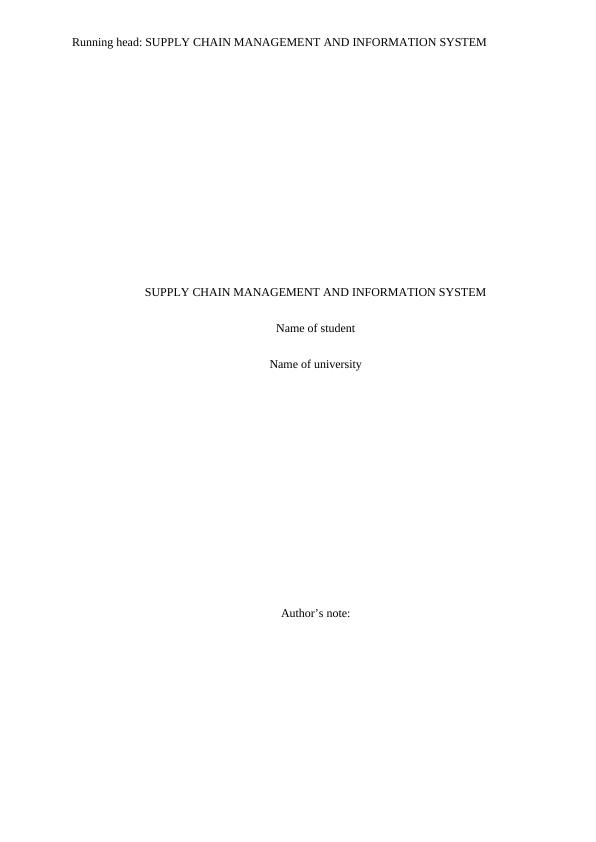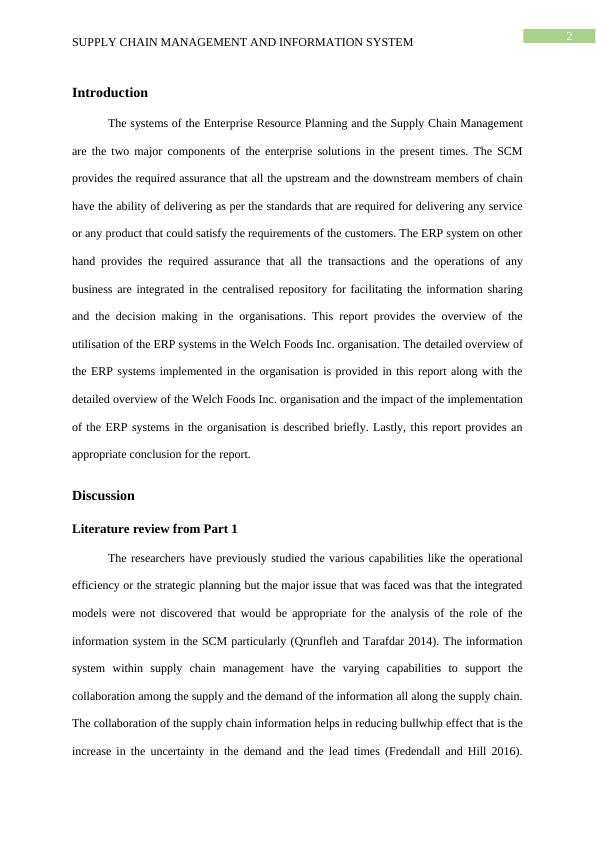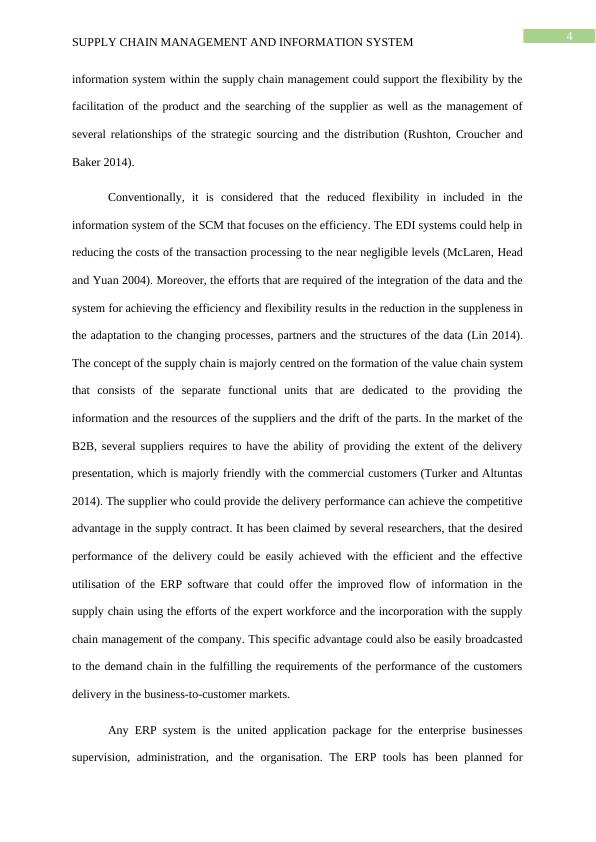Supply Chain Management and Information System
Added on 2023-01-18
21 Pages5168 Words33 Views
Running head: SUPPLY CHAIN MANAGEMENT AND INFORMATION SYSTEM
SUPPLY CHAIN MANAGEMENT AND INFORMATION SYSTEM
Name of student
Name of university
Author’s note:
SUPPLY CHAIN MANAGEMENT AND INFORMATION SYSTEM
Name of student
Name of university
Author’s note:

1
SUPPLY CHAIN MANAGEMENT AND INFORMATION SYSTEM
Table of Contents
Introduction....................................................................................................................2
Discussion......................................................................................................................2
Literature review from Part 1.....................................................................................2
Case study..................................................................................................................6
Description of the organisation..................................................................................6
Description of the Oracle Supply Chain Management (Oracle EBusiness Suite).....7
Integration methods....................................................................................................8
Impact of the ERP system on the business of Welch’s............................................11
Conclusion....................................................................................................................14
References....................................................................................................................16
SUPPLY CHAIN MANAGEMENT AND INFORMATION SYSTEM
Table of Contents
Introduction....................................................................................................................2
Discussion......................................................................................................................2
Literature review from Part 1.....................................................................................2
Case study..................................................................................................................6
Description of the organisation..................................................................................6
Description of the Oracle Supply Chain Management (Oracle EBusiness Suite).....7
Integration methods....................................................................................................8
Impact of the ERP system on the business of Welch’s............................................11
Conclusion....................................................................................................................14
References....................................................................................................................16

2
SUPPLY CHAIN MANAGEMENT AND INFORMATION SYSTEM
Introduction
The systems of the Enterprise Resource Planning and the Supply Chain Management
are the two major components of the enterprise solutions in the present times. The SCM
provides the required assurance that all the upstream and the downstream members of chain
have the ability of delivering as per the standards that are required for delivering any service
or any product that could satisfy the requirements of the customers. The ERP system on other
hand provides the required assurance that all the transactions and the operations of any
business are integrated in the centralised repository for facilitating the information sharing
and the decision making in the organisations. This report provides the overview of the
utilisation of the ERP systems in the Welch Foods Inc. organisation. The detailed overview of
the ERP systems implemented in the organisation is provided in this report along with the
detailed overview of the Welch Foods Inc. organisation and the impact of the implementation
of the ERP systems in the organisation is described briefly. Lastly, this report provides an
appropriate conclusion for the report.
Discussion
Literature review from Part 1
The researchers have previously studied the various capabilities like the operational
efficiency or the strategic planning but the major issue that was faced was that the integrated
models were not discovered that would be appropriate for the analysis of the role of the
information system in the SCM particularly (Qrunfleh and Tarafdar 2014). The information
system within supply chain management have the varying capabilities to support the
collaboration among the supply and the demand of the information all along the supply chain.
The collaboration of the supply chain information helps in reducing bullwhip effect that is the
increase in the uncertainty in the demand and the lead times (Fredendall and Hill 2016).
SUPPLY CHAIN MANAGEMENT AND INFORMATION SYSTEM
Introduction
The systems of the Enterprise Resource Planning and the Supply Chain Management
are the two major components of the enterprise solutions in the present times. The SCM
provides the required assurance that all the upstream and the downstream members of chain
have the ability of delivering as per the standards that are required for delivering any service
or any product that could satisfy the requirements of the customers. The ERP system on other
hand provides the required assurance that all the transactions and the operations of any
business are integrated in the centralised repository for facilitating the information sharing
and the decision making in the organisations. This report provides the overview of the
utilisation of the ERP systems in the Welch Foods Inc. organisation. The detailed overview of
the ERP systems implemented in the organisation is provided in this report along with the
detailed overview of the Welch Foods Inc. organisation and the impact of the implementation
of the ERP systems in the organisation is described briefly. Lastly, this report provides an
appropriate conclusion for the report.
Discussion
Literature review from Part 1
The researchers have previously studied the various capabilities like the operational
efficiency or the strategic planning but the major issue that was faced was that the integrated
models were not discovered that would be appropriate for the analysis of the role of the
information system in the SCM particularly (Qrunfleh and Tarafdar 2014). The information
system within supply chain management have the varying capabilities to support the
collaboration among the supply and the demand of the information all along the supply chain.
The collaboration of the supply chain information helps in reducing bullwhip effect that is the
increase in the uncertainty in the demand and the lead times (Fredendall and Hill 2016).

3
SUPPLY CHAIN MANAGEMENT AND INFORMATION SYSTEM
According to several researchers, the information system in the SCM could enables the
increasingly accurate and the timely coordination of the information, that helps in reducing
the inventory and the costs of the administration and it also increases the responsiveness to
the demands of the market. The effective utilisation of the information system in the SCM
could help in reducing the buffer inventory stocks, decrease the lead times, upsurge the sales
as well as enhance the customer service (Wu, Chuang and Hsu 2014). The benefits that are
achievable utilising the SCM IS have been immensely prejudiced by the quantity of the issues
like the measure of how systems support the requirements of the flexibility and the efficiency
of supply chain or level of the belief among the allies of trading.
While reviewing the earlier studies of information system within the supply chain
management and the information system among the organisations, the major capabilities of
the information system within the supply chain that have emerged as the most relevant
discussion to the coordination initiatives of the supply chain have been identified (Hazen et
al. 2014). The capabilities of the organisation that have been enabled by the information
system has been discovered by several researchers. Commonly, the firms with the strategies
that are increasingly focussed on the cost requires the enhanced support of the information
system for enhancing the operational efficiency but it has been discovered that the companies
that are majorly focussed on the strategies of the differentiation requires increased operational
flexibility. The operational flexibility and the efficiency are frequently viewed as the
unrealistic or the incompatible goals. The information systems in the supply chain
management are sometimes observed as inhibitors instead of the flexibility enablers
(Govindan et al. 2014). Moreover, it has been discovered by several researchers that the
effective information system utilisation in the supply chain management could help in
enhancing the operational flexibility by the automation of the repetitive responsibilities and
the deliverance up the resources for concentrating the non-routine tasks. Similar to this,
SUPPLY CHAIN MANAGEMENT AND INFORMATION SYSTEM
According to several researchers, the information system in the SCM could enables the
increasingly accurate and the timely coordination of the information, that helps in reducing
the inventory and the costs of the administration and it also increases the responsiveness to
the demands of the market. The effective utilisation of the information system in the SCM
could help in reducing the buffer inventory stocks, decrease the lead times, upsurge the sales
as well as enhance the customer service (Wu, Chuang and Hsu 2014). The benefits that are
achievable utilising the SCM IS have been immensely prejudiced by the quantity of the issues
like the measure of how systems support the requirements of the flexibility and the efficiency
of supply chain or level of the belief among the allies of trading.
While reviewing the earlier studies of information system within the supply chain
management and the information system among the organisations, the major capabilities of
the information system within the supply chain that have emerged as the most relevant
discussion to the coordination initiatives of the supply chain have been identified (Hazen et
al. 2014). The capabilities of the organisation that have been enabled by the information
system has been discovered by several researchers. Commonly, the firms with the strategies
that are increasingly focussed on the cost requires the enhanced support of the information
system for enhancing the operational efficiency but it has been discovered that the companies
that are majorly focussed on the strategies of the differentiation requires increased operational
flexibility. The operational flexibility and the efficiency are frequently viewed as the
unrealistic or the incompatible goals. The information systems in the supply chain
management are sometimes observed as inhibitors instead of the flexibility enablers
(Govindan et al. 2014). Moreover, it has been discovered by several researchers that the
effective information system utilisation in the supply chain management could help in
enhancing the operational flexibility by the automation of the repetitive responsibilities and
the deliverance up the resources for concentrating the non-routine tasks. Similar to this,

4
SUPPLY CHAIN MANAGEMENT AND INFORMATION SYSTEM
information system within the supply chain management could support the flexibility by the
facilitation of the product and the searching of the supplier as well as the management of
several relationships of the strategic sourcing and the distribution (Rushton, Croucher and
Baker 2014).
Conventionally, it is considered that the reduced flexibility in included in the
information system of the SCM that focuses on the efficiency. The EDI systems could help in
reducing the costs of the transaction processing to the near negligible levels (McLaren, Head
and Yuan 2004). Moreover, the efforts that are required of the integration of the data and the
system for achieving the efficiency and flexibility results in the reduction in the suppleness in
the adaptation to the changing processes, partners and the structures of the data (Lin 2014).
The concept of the supply chain is majorly centred on the formation of the value chain system
that consists of the separate functional units that are dedicated to the providing the
information and the resources of the suppliers and the drift of the parts. In the market of the
B2B, several suppliers requires to have the ability of providing the extent of the delivery
presentation, which is majorly friendly with the commercial customers (Turker and Altuntas
2014). The supplier who could provide the delivery performance can achieve the competitive
advantage in the supply contract. It has been claimed by several researchers, that the desired
performance of the delivery could be easily achieved with the efficient and the effective
utilisation of the ERP software that could offer the improved flow of information in the
supply chain using the efforts of the expert workforce and the incorporation with the supply
chain management of the company. This specific advantage could also be easily broadcasted
to the demand chain in the fulfilling the requirements of the performance of the customers
delivery in the business-to-customer markets.
Any ERP system is the united application package for the enterprise businesses
supervision, administration, and the organisation. The ERP tools has been planned for
SUPPLY CHAIN MANAGEMENT AND INFORMATION SYSTEM
information system within the supply chain management could support the flexibility by the
facilitation of the product and the searching of the supplier as well as the management of
several relationships of the strategic sourcing and the distribution (Rushton, Croucher and
Baker 2014).
Conventionally, it is considered that the reduced flexibility in included in the
information system of the SCM that focuses on the efficiency. The EDI systems could help in
reducing the costs of the transaction processing to the near negligible levels (McLaren, Head
and Yuan 2004). Moreover, the efforts that are required of the integration of the data and the
system for achieving the efficiency and flexibility results in the reduction in the suppleness in
the adaptation to the changing processes, partners and the structures of the data (Lin 2014).
The concept of the supply chain is majorly centred on the formation of the value chain system
that consists of the separate functional units that are dedicated to the providing the
information and the resources of the suppliers and the drift of the parts. In the market of the
B2B, several suppliers requires to have the ability of providing the extent of the delivery
presentation, which is majorly friendly with the commercial customers (Turker and Altuntas
2014). The supplier who could provide the delivery performance can achieve the competitive
advantage in the supply contract. It has been claimed by several researchers, that the desired
performance of the delivery could be easily achieved with the efficient and the effective
utilisation of the ERP software that could offer the improved flow of information in the
supply chain using the efforts of the expert workforce and the incorporation with the supply
chain management of the company. This specific advantage could also be easily broadcasted
to the demand chain in the fulfilling the requirements of the performance of the customers
delivery in the business-to-customer markets.
Any ERP system is the united application package for the enterprise businesses
supervision, administration, and the organisation. The ERP tools has been planned for

5
SUPPLY CHAIN MANAGEMENT AND INFORMATION SYSTEM
addressing the disintegration of the information all through the business of the enterprise for
integrating the inter- and the intra- enterprise information (Prause and Hunke 2014). When
the consideration of the ERP integration is done among the enterprises for the seamless
performance of the supply chain, the major differences among the kinds of the ERP that are
adopted by the customers and the suppliers tangled in supply chain can help in creating the
issues of incompatibility. It has been further suggested by several researchers that the
enterprises must not depend solely on the ERP for the administration of the supply chain. Due
to the firm design and the incapability of dealing with the uncertainty, several other systems
or the technologies like the mobile technology, RFID and the wireless technology would also
help in the improving of the order, product and the part traceability in the supply chain (Tian
2016). It has been also discovered that the small scale business or the organisations cannot
afford the implementation of the information system in the organisation for enhancing the
supply chain management. The EDI or the Electronic Data Interchange is being extensively
utilised for transferring the information among providers and the customers involved the
supply chain. It has been discovered that the Wal-mart and several additional cost-sensitive
along with the value chain enlightened enterprises utilise the technology of RFID and it
would help in the revolutionising the methods by which the enterprises tracks the inventory.
There are several studies and the researches that are focusing on the SCM, IS and the
logistics but these studies are majorly country specific or it follows the micro approach
instead of the region-focus (Waters and Rinsler 2014). Although the micro-approach which
has been principally instigated earlier is critical in the accepting of the LSCM in the distinct
countries, it is of the restricted worth for the assessment of the region completely.
Particularly, the information systems within the supply chain management must not solely
support the internal collaboration but it must also provide the required support the
coordination among the organisation using the coordination and the exchange of the tactical
SUPPLY CHAIN MANAGEMENT AND INFORMATION SYSTEM
addressing the disintegration of the information all through the business of the enterprise for
integrating the inter- and the intra- enterprise information (Prause and Hunke 2014). When
the consideration of the ERP integration is done among the enterprises for the seamless
performance of the supply chain, the major differences among the kinds of the ERP that are
adopted by the customers and the suppliers tangled in supply chain can help in creating the
issues of incompatibility. It has been further suggested by several researchers that the
enterprises must not depend solely on the ERP for the administration of the supply chain. Due
to the firm design and the incapability of dealing with the uncertainty, several other systems
or the technologies like the mobile technology, RFID and the wireless technology would also
help in the improving of the order, product and the part traceability in the supply chain (Tian
2016). It has been also discovered that the small scale business or the organisations cannot
afford the implementation of the information system in the organisation for enhancing the
supply chain management. The EDI or the Electronic Data Interchange is being extensively
utilised for transferring the information among providers and the customers involved the
supply chain. It has been discovered that the Wal-mart and several additional cost-sensitive
along with the value chain enlightened enterprises utilise the technology of RFID and it
would help in the revolutionising the methods by which the enterprises tracks the inventory.
There are several studies and the researches that are focusing on the SCM, IS and the
logistics but these studies are majorly country specific or it follows the micro approach
instead of the region-focus (Waters and Rinsler 2014). Although the micro-approach which
has been principally instigated earlier is critical in the accepting of the LSCM in the distinct
countries, it is of the restricted worth for the assessment of the region completely.
Particularly, the information systems within the supply chain management must not solely
support the internal collaboration but it must also provide the required support the
coordination among the organisation using the coordination and the exchange of the tactical

End of preview
Want to access all the pages? Upload your documents or become a member.
Related Documents
Supply Chain Management and Information Systemlg...
|9
|2213
|40
Information Strategy and Managementlg...
|6
|1183
|18
Dell IT Supply Chain Strategieslg...
|13
|2197
|21
Supply Chain Management (SCM) Assignmentlg...
|32
|4918
|134
Improving Supply Chain Management of Amazon Inc.lg...
|10
|3516
|103
The Benefits of ERP in Supply Chainlg...
|7
|1498
|238
